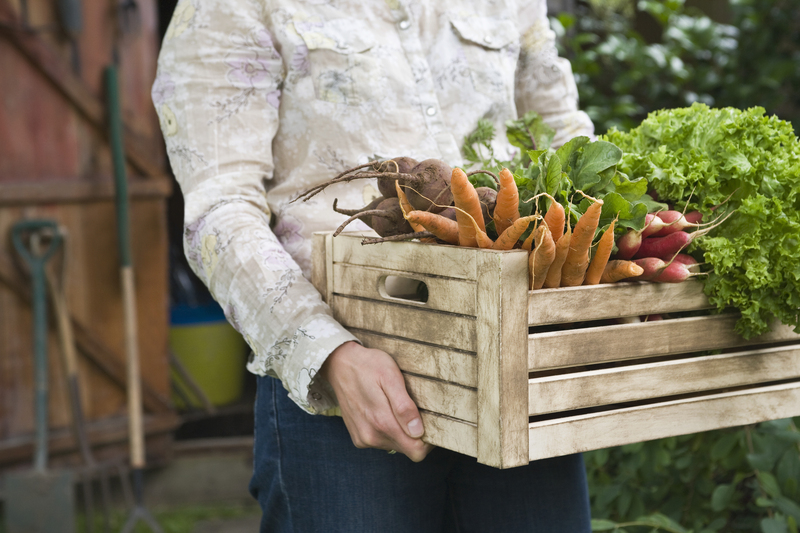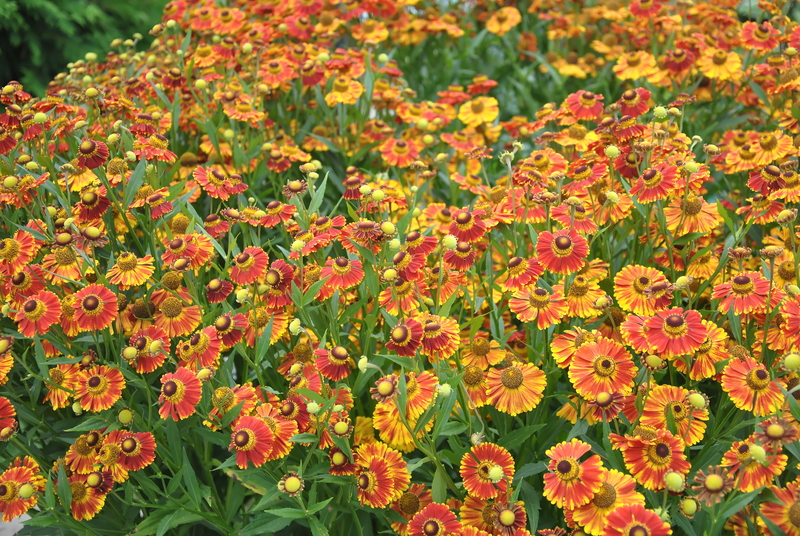Exploring the World of Vertical Gardening
Posted on 03/09/2025
Exploring the World of Vertical Gardening: Unlocking New Green Spaces
Are you passionate about gardening, but lack the space to create the lush oasis of your dreams? Vertical gardening offers a wonderful solution. Whether you're an urban resident with a compact balcony, a homeowner seeking to maximize your yard area, or a novice gardener experimenting with innovative ideas, vertical gardens can transform limited spaces into breathtaking displays of greenery. In this comprehensive article, we'll delve deep into the world of vertical gardening, its variations, benefits, and step-by-step strategies to help you start your own vertical garden.

What is Vertical Gardening?
Vertical gardening is an innovative gardening technique that involves growing plants upward, typically on walls, fences, or specially designed vertical structures, rather than relying on traditional horizontal ground beds. This approach enables gardeners to optimize space, beautify urban environments, and even boost air quality indoors and outdoors. Living walls, green walls, and plant towers are all examples of vertical gardens.
The Evolution of Vertical Gardening
While vertical gardening might seem like a modern innovation, its roots stretch deep into history. The legendary Hanging Gardens of Babylon are among the earliest examples of manmade vertical landscapes. Modern vertical gardening owes much to visionaries like French botanist Patrick Blanc, who pioneered lush vertical plant installations on building facades. Today, with urbanization and shrinking green spaces, vertical gardening continues to evolve and gain popularity around the world.
The Many Benefits of Vertical Gardens
Gardeners and city dwellers alike are embracing vertical gardens for a range of compelling reasons:
- Space Efficiency: Transform small balconies, patios, or exterior walls into productive gardens without sacrificing floor space.
- Improved Air Quality: Plants filter toxins and release oxygen, significantly improving both indoor and outdoor air quality.
- Thermal Insulation: Vertical gardens insulate buildings, reducing heat absorption, lowering indoor temperatures, and decreasing energy consumption.
- Noise Reduction: Dense, multi-layered green walls absorb and reduce urban noise pollution.
- Aesthetic Appeal: Enhance bland structures with vibrant greenery, turning empty walls into stunning natural artworks.
- Biodiversity: Support pollinators and urban wildlife by providing food, shelter, and breeding grounds in cities.
- Mental Well-being: Proximity to greenery has been consistently linked to reduced stress, improved mood, and increased productivity.
Environmental Impact of Vertical Gardening
Beyond beautification, vertical gardening plays a significant role in sustainable urban environments. By maximizing plant density per square foot, vertical gardens help reduce urban heat islands, sequester carbon, and create critical microhabitats for insects and birds. Strategic placement of living walls can even regulate stormwater runoff and limit erosion, especially in metropolitan settings with limited permeable surfaces.
Types of Vertical Gardens
Vertical gardens come in many shapes and forms, allowing gardeners to tailor their green spaces to available area, sunlight, and personal preferences. Here's an overview of the most popular vertical gardening methods:
- Living Walls and Green Walls: Large installations where a wide assortment of plants grow on vertically suspended panels, often supported with an integrated irrigation system. These are used indoors or outdoors, on residential, commercial, or even public buildings.
- Vertical Planters and Wall Pockets: Modular containers or fabric pockets attached directly to walls or fencing, ideal for herbs, succulents, and flowering plants. They are popular in smaller spaces and can be easily rearranged or replaced.
- Trellises and Climbing Frames: Provide structural support for vining or climbing plants such as tomatoes, beans, peas, or flowering vines like clematis and morning glory.
- Recycled Pallet Gardens: Old wooden pallets can be upcycled to house rows of colorful plants. These are cost-effective, sustainable, and perfect for DIY projects.
- Vertical Tower Gardens: Self-contained, often hydroponic towers that allow multiple crops to be grown up a central column, frequently used for edible gardening in small urban spaces.
Choosing the Right Vertical Garden for You
When selecting a vertical garden system, consider:
- The amount of sunlight your chosen wall or area receives.
- The types of plants you want to grow (edible, ornamental, succulent, etc.).
- Your budget and desired maintenance level.
- Structural support and weight-bearing limitations of your wall or fence.
- Indoor vs. outdoor use and exposure to the elements.
Best Plants for Vertical Gardening
The success of your vertical gardening project hinges largely on plant selection. The best plants for vertical gardens are those that thrive in shallow soil, can adapt to vertical growth, and meet your aesthetic or culinary goals.
Top Choices for Edible Vertical Gardens
- Leafy greens: Lettuce, spinach, kale, swiss chard, and arugula--fast-growing and ideal for harvesting fresh salads.
- Herbs: Basil, parsley, cilantro, mint, oregano, thyme, and chives--compact and high-yielding in limited spaces.
- Strawberries: Perfect for hanging planters and wall pockets.
- Tomatoes and Peppers: Choose compact, determinate or bush varieties for best results in containers.
- Climbing beans and peas: Utilize trellises for bountiful harvests.
Ornamental and Flowering Plants
- Succulents: Sedum, echeveria, crassula - thrive in low-water vertical gardens.
- Ferns: Boston ferns and maidenhair ferns add lushness to shaded locations.
- Trailing Flowers: Petunias, lobelia, nasturtium, and fuchsia create cascading color displays.
- Pothos, philodendron, and English ivy: Popular for indoor vertical wall gardens due to their low maintenance needs.
Tip: Always match your plant choices to your microclimate. Sun lovers won't thrive on a shaded wall, while shade-loving ferns prefer cooler, protected spots.
How to Start Your Own Vertical Garden
Embarking on your own vertical gardening adventure is easier than you think! Here is a step-by-step guide:
-
Assess Your Space and Goals
Determine where you want to set up your vertical garden. Is it an indoor living wall, an outdoor patio, or a kitchen herb garden? Measure the available area, study sunlight patterns, and decide on your primary objectives: fresh produce or visual appeal? -
Select the Right System and Plants
Choose a vertical gardening system that fits your space. Opt for wall-mount planters for tight spots, trellises for climbers, pocket planters for herbs, or hydroponic towers for high productivity. -
Prepare and Install the Support Structure
Secure your vertical garden frame, ensuring it can bear the combined weight of plants, soil, and water. Use weather-resistant materials outdoors, and make sure there's a provision for drainage. -
Set Up Irrigation and Drainage
Consider automatic drip irrigation for larger walls or hand-watering for smaller setups. Good drainage is vital to prevent waterlogging and root rot. -
Plant Carefully
Fill pockets or containers with high-quality soil or hydroponic medium. Arrange plants with similar sunlight and water needs together. Place drought-tolerant species higher up, as water trickles down. -
Maintain Regularly
Monitor moisture levels, fertilize as needed, prune for shape, and remove dead leaves to encourage healthy growth. Vertical gardens can be low-maintenance with the right plant selection. -
Enjoy and Experiment
Celebrate the transformation of your space! Try rotating plants seasonally and experiment with combinations to see what thrives.
DIY Vertical Gardening: Inspiring Ideas
- Pallet Planter Wall: Recycle a wooden pallet, line it with landscape fabric, fill with soil, and insert succulents or herbs into the slats.
- Shoe Organizer Garden: Hang an unused canvas shoe organizer and use each pocket for a different herb or flower.
- Tower of Pots: Stack graduated pots in a pyramid, securing them with a central pole, to create a vertical strawberry or herb garden.
- Bottle Wall: Upcycle plastic bottles by cutting openings and attaching them to a fence in staggered rows for a whimsical vegetable garden.
Challenges of Vertical Gardening & How to Overcome Them
While vertical gardening brings numerous advantages, there are unique challenges to address.
- Watering Issues: Vertical gardens dry out faster than horizontal beds. Solve this with automated drip irrigation systems or thorough hand watering, especially during hot, dry periods.
- Support and Stability: Structures must be sturdy and securely fixed, especially for large or outdoor gardens exposed to wind. Use hardware rated for the weight and consider windbreaks.
- Pest Management: Pests can be more difficult to detect in dense plantings. Inspect regularly, encourage beneficial insects, and, if needed, use safe organic pesticides.
- Soil Nutrition: Limited soil volume means nutrients are depleted quickly. Apply slow-release fertilizers or liquid feeds to keep plants healthy.
- Sunlight Distribution: Upper tiers may shade lower levels. Rotate plant placements or choose shade-tolerant varieties for the bottom rows.
Expert Tips for Flourishing Vertical Gardens
- Group Plants by Needs: Place plants with similar light, water, and nutrient requirements together for optimal performance.
- Start With Seedlings: Transplant young plants rather than sowing seeds directly to ensure robust establishment.
- Plan for Growth: Allow ample room for each plant to spread, preventing overcrowding and promoting airflow.
- Monitor Moisture: Regularly check for dry pockets, especially at the top of the structure.
- Embrace Creativity: Use color, leaf texture, and plant height variations to design visually compelling gardens.
Vertical Gardening Indoors: Bring Nature Into Your Home
Indoor vertical gardening is booming, with living walls featured in homes, restaurants, and offices worldwide. Beyond pure aesthetics, indoor green walls regulate humidity, absorb indoor toxins, and provide a calming environment. Popular indoor vertical gardens use modular plastic panels, hydroponic systems, or felt pockets attached to walls. Low-light plants like pothos, ferns, philodendrons, and peace lilies are excellent choices.
Creating Your Indoor Vertical Oasis
- Choose a bright wall with filtered natural light or supplement with grow lights.
- Install a waterproof barrier and drip tray to protect interior walls.
- Design with maintenance in mind, as indoor gardens need occasional pruning and cleaning.

Future Trends in Vertical Gardening
With global urban populations rising and green space dwindling, vertical gardening will only become more vital. Architects and city planners now integrate living facades and rooftop vertical farms into new projects, blurring the line between nature and architecture. Smart irrigation technology, advanced hydroponics, and AI-driven plant care systems ensure thriving gardens even for busy city dwellers.
Community-based vertical farms are also gaining traction, providing fresh produce, education, and green jobs in food deserts. These remarkable vertical gardening innovations have the power to transform cities, boost food security, and reconnect people with nature.
Conclusion: Embrace the Vertical Gardening Revolution
If you're searching for practical, ecological, and visually stunning ways to garden in limited spaces, vertical gardening opens up a world of possibilities. From lush living walls to compact herb towers, these systems offer enormous flexibility and a host of benefits--environmentally and personally. Whether for food, beauty, or well-being, vertical gardens stand as a testament to human creativity and adaptability.
Start exploring the world of vertical gardening today--bring nature to your walls and discover how high your gardening dreams can grow!

